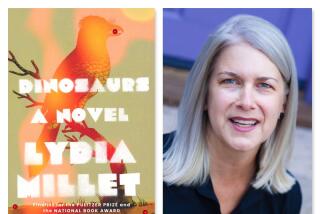Tracy Chevalier chases dinosaurs
- Share via
Reporting from London — Tracy Chevalier sits in the Victorian grandeur of London’s Museum of Natural History next to the skeletal remains of a giant eye, the shape and size of a pineapple ring.
“It’s so big it’s kind of funny. . . . It’s like a cartoon. But that’s often the quality of dinosaurs. Everything about them seems to be exaggerated, their teeth, their size, their claws . . . ,” says the author of “Girl With a Pearl Earring.”
The eye belongs to a plesiosaur and was found in the English seaside town of Lyme Regis in the early 1800s by amateur fossil hunter and seller Mary Anning -- the subject of Chevalier’s new novel, “Remarkable Creatures.”
From the moment Anning is struck by lightning as a baby -- “which people said made her strange and extra-bright” -- it is clear she is marked for greatness, says Chevalier.
In the book, working-class Anning meets the middle-class unmarried Elizabeth Philpot, and through their mutual love for fossils the two strike up a strange camaraderie.
Anning, who is thought to be the inspiration for the tongue-twister “She Sells Sea Shells on the Sea Shore,” is on the hunt for what she believes to be a giant crocodile similar to one (later named an ichthyosaurus) she found in 1811 when she was 12, which later rocked the scientific world.
Then one fateful day, she finds herself staring into the eye of the strangest beast she’s ever encountered.
“The eye is enormous,” says Chevalier, her voice echoing around the Richard Owen- designed “cathedral of nature,” while a dimly lighted statue of Charles Darwin looks on from its rear.
“When you look at it, you realize the minute her and Elizabeth saw it they must have known it couldn’t be a crocodile.”
Professor Philip Davis of Liverpool University, author of “Why Victorian Literature Still Matters,” said there are two types of writing about the 19th century.
“There’s the patronizing stuff,” he says. “Victorian repression, covering up piano legs, that kind of nonsense which wants to make us seem, oh, so cool and progressive.”
However, he says the 19th century comes to life when writers see how it is the foundation of our modern life in “all its questionings, discoveries and innovations.”
He said the fascination with writing about the time is that “the problems and conflicts of the modern world began there -- in matters of faith and science, family and women’s rights, vocation and economics.”
In “Remarkable Creatures,” which comes out in the United States on Tuesday, Anning’s finds challenge ideas about the world’s creation and stimulate debate about our origins. She unearthed a plesiosaur in 1823, a pterodactyl in 1828 and a squaloraja (a transition fish, between sharks and rays) in 1829. But in an arena dominated by men, she is soon reduced to a serving role, facing prejudice from the academic community, vicious gossip from neighbors and the heartbreak of forbidden love.
This provides the central narrative as Anning emerges to become a famous fossil hunter, with friend and protector Philpot to defend her against the men who try to take credit for her finds.
In 1984, Chevalier moved from Washington to London, where she lives with her husband and son.
She enjoyed enormous success with “Girl With a Pearl Earring” (1999), worked in a cemetery for “Falling Angels” (2001), spent time in a medieval tapestry studio for “The Lady and the Unicorn” (2003) and researched the making of Dorset buttons for “Burning Bright” (2007).
And on this day, she’s bouncing from display to display of dinosaurs.
“This is a relative of a plesiosaur . . . has a huge jaw,” she says, pointing to a large glass case in the main hall.
Chevalier says that before she discovered Anning’s story “in a little dinosaur museum in the English town of Dorchester,” she really knew nothing about things such as plesiosaurs.
“I’m as surprised as anyone else. . . . My background is not science. It’s art or literature, but I always like to try to challenge myself and go in a new direction with books; otherwise, I get in a rut and write the same thing,” she says.
“I want to keep readers guessing, and myself guessing too, so it was like opening up a whole new world that I spent 2 1/2 years finding out about.”
Brogden writes for the Associated Press.
More to Read
Sign up for our Book Club newsletter
Get the latest news, events and more from the Los Angeles Times Book Club, and help us get L.A. reading and talking.
You may occasionally receive promotional content from the Los Angeles Times.







